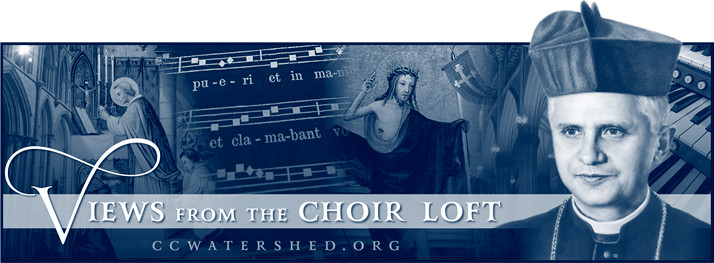 EENLY AWARE. I am keenly aware of my flaws as a choirmaster. One of them is my reluctance to “take risks” with my singers, especially when it comes to high or low tessitura. In an effort to counteract this tendency, we are doing an experiment with the (all female) TREBLE CHOIR I direct. Specifically, we are doing something Dr. Horst Buchholz often does at the Cathedral Basilica of St. Louis: adding a polyphonic section to Credo VII at the words “Et Incarnatus Est.”
EENLY AWARE. I am keenly aware of my flaws as a choirmaster. One of them is my reluctance to “take risks” with my singers, especially when it comes to high or low tessitura. In an effort to counteract this tendency, we are doing an experiment with the (all female) TREBLE CHOIR I direct. Specifically, we are doing something Dr. Horst Buchholz often does at the Cathedral Basilica of St. Louis: adding a polyphonic section to Credo VII at the words “Et Incarnatus Est.”
Readers already know that musical diversity at Mass is something we believe to be essential; and we harp on this subject often—if you’ll pardon the pun! It would seem that Papal Masses in the time of Giovanni Maria Nanino (d. 1607) show diversity as well. At the bottom of this article, I have included a quote which talks about 16th century Papal Masses, and you’ll notice they utilize different performing forces for specific parts of the Mass, such as a TREBLE CHOIR for the “Kyrie” on Ferial days. Here’s the “polyphonic extension” we are attempting with my TREBLE CHOIR (all female):
* PDF Download • Polyphonic Addition to Credo VII
—In 1571, Nanino replaced Palestrina as Maestro di cappella at the Basilica of St. Mary Major.
Rehearsal videos for each individual voice await you at #63702 .
![]()
Sometimes the rehearsal videos are a tad fast, but in real life we slow things down to an appropriate tempo based on the acoustic.

The Full Quote: Below is the full quotation vis-à-vis Nanino, courtesy of Monsignor Richard J. Schuler:
Nanino in his “Diario” furnishes us with a complete picture of the year’s activity of a papal singer. He lists the feasts on which—in addition to all Sundays—no singer could be excused from his obligation. Thus he has left us a record of the feast days celebrated by the papal household with special solemnity at the end of the sixteenth century. […] Nanino indicates to some extent the kind of music employed depending on the liturgical rank of the day being celebrated. For example, he specifies that on ferial days (week days without a special feast) the office of Matins and all the hours are only read. The “Introit” of the Mass is sung in plain chant (canto fermo), and the gradual and the tract are sung by the choir of canons (a choro). The “Kyrie” is to be sung by the treble voices (voce alta) and the “Offertory” is performed in counterpoint. He directs that the “Sanctus” be done in parts (in musica) and the “Communion Anthem” in chant, alternating with the treble voices (meditante in voce alta). Vespers are done in chant, except for the antiphon to the “Magnificat” which is sung in counterpoint. A more elaborate arrangement is indicated for feast days. […] Nanino takes considerable pains to establish his system of keeping the records of disciplinary infractions, since that was his obligation as punctator. He seems to say that he is giving fair warning to all of how he will proceed. It almost points to the existence of complaints against his attitude, rather than just a forestalling of future arguments over his system. First, he takes up the question of absences, noting that each singer could miss two days in a year’s time, provided those days were not Sundays, feasts of the Blessed Virgin, the Apostles or Evangelists, or any day listed in the calendar at the beginning of his “Diario.” Neither could anyone miss a public consistory held in the Sala Ducale of the Vatican palace. He solves the problem of the distinction between absences and tardiness by declaring that a singer who is not in his place by the end of the Epistle will be marked absent. Fines vary according to the rank of the day on which the tardiness or absence occurred, and if any bonus (regaglia) should come to the singers because of an appearance of the choir at a function outside the Sistine chapel, the culprit would forfeit his share. At papal Masses, the regulations against tardiness were more stringent than at Masses celebrated by cardinals or bishops. Nanino records that any singer who is “not in his place and in his vestments” by the end of the repetition of the “Introit” will be fined eight vinti. At papal Vespers, the singer who is not present at the “Gloria Patri” of the first psalm pays a fine of fifty balocchi.

